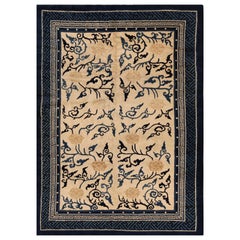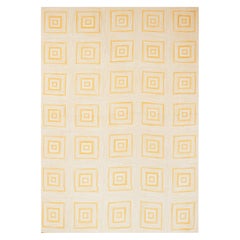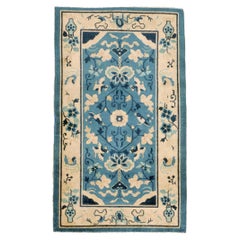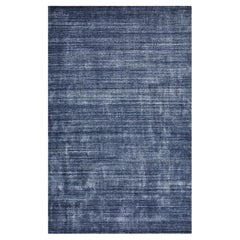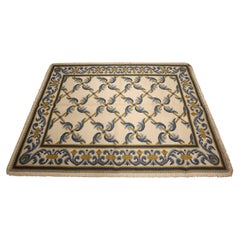Chinese More Carpets
Color: White
Place of Origin: Chinese
Handwoven Cream Red Needlepoint Carpet Traditional Wool Area Rug
Located in Hampshire, GB
This elegant rug style is popular within Oriental rug shops due to the high demand from both interior designers and homeowners. The design features an open centre field that has been...
Category
2010s Country Chinese More Carpets
Materials
Organic Material, Natural Fiber, Cotton, Wool
Antique Chinese Peking Rug. 6 ft x 8 ft 2 in
Located in New York, NY
Antique Chinese Peking Cream And Blue Rug, Country of Origin / rug type: China, Circa date: 1900. Size: 6 ft x 8 ft 2 in (1.83 m x 2.49 m)
Category
20th Century Chinese Chippendale Chinese More Carpets
Materials
Wool
Large Antique 20th Century Chinese Oriental Silk Rug Cream Green Lotus Flowers
Located in Sherborne, Dorset
A very attractive and large Chinese silk rug with central floral motif and stylised linked chain lattice in subtle colours depicting lotus flowers, symbols of wealth and foliage on a...
Category
Mid-20th Century Chinese Export Chinese More Carpets
Materials
Silk
Early 20th Century Handmade Chinese Peking Long Gallery Carpet in Cream & Blue
Located in New York, NY
An antique Chinese Peking long gallery carpet handmade during the early 20th century in shades of cream and blue.
Measures: 5' 9" x 16' 3"
The craft of the hand-knotted carpet in China, and the surrounding areas including Mongolia and Tibet, extends into the early centuries of the first millennium, C.E., but we really have a firm grasp only beginning in the later 16th century with large, very coarsely woven carpets, often depicting dragons, created for the Imperial Forbidden City palaces. Chinese carpets have always been commercial and there are no tribal groups responsible for any of the carpet weaving strains.
When the Ming Dynasty fell in 1644, with no Imperial patrons, production moved to the city of Ningxia in north central China where several workshops turned out more finely woven pieces for the Mandarins of the administrative Ch’ing bureaucracy and well-to-do merchants. Ningxia was the major Chinese carpet center up through most of the 19th century, with first allover and then medallion designs on cotton foundations in medium weaves. Palettes were initially limited to yellows, dark blue and cream, but later widened to include reds, browns and even green. These antiques were the first Chinese carpets to be exported to the West and they fitted in well with the craze for Chinese blue-and-white porcelain in the second half of the 19th century. Ningxia also wove shaped and rectangular small rugs for saddle underlays, chair (“throne”) seats and shaped backs, pillar carpets with dragons or monks for Buddhist monasteries, and long divided runners for monastery meditation halls. These small rugs are among the most collectible of all Chinese weavings.
Weavers from Ningxia set up workshops in the capital Peking (Beijing) in the 1860’s and began weaving Western room sizes for export, primarily to America. In blue – and – white and polychrome palettes, with round wreath medallions, precious objects, seasonal flowers, paeonies, lotuses, fretwork, clouds, butterflies and bats, all relatively spaciously drawn. The round “Shou” (Good Luck) character is also a prominent decorative motif. There are also a few Peking landscape pictorials with pagodas, houses, bridges, waterscapes and boats. Peking carpets were woven right up until WWII and production began again after the Cultural Revolution around 1970. They are moderately well-woven, on cotton foundations, exactingly executed and indisputably Chinese. Many are in the blue-and-white style. Nothing else looks like a Peking carpet and for a Chinese “look” in a room, they are absolutely indispensable. Sizes range from scatters and a few runners, through the popular 9’12’ size, to large carpets over 20’ which must have been special orders. The earliest Peking Revival carpets are pliable and fairly thin, but they became heavier and more compact in the 20th century, in competition with Art Deco carpets from Tientsin. The modern, post- 1970, pieces are in the traditional Peking style, but are a little too regular and neat. Exactitude has been favored over character, as hard to explain that as it is.
There are a number of all-silk and silk-and –metal thread pieces, many with inscriptions purporting to link them with rooms in the Imperial palaces, bringing very substantial auction prices, but none are really antique. The genre emerged after WWI and the present demand comes from mainland Chinese. The silk piles often stand in pattern relief against flat woven gold metal thread grounds. The inscriptions are apocryphal, the rugs are flashily opulent, perfect for nouveaux riches.
The Art Deco period between the two World Wars saw a distinctive carpet industry developing in Tientsin (Tianjin) in northeastern China. These are highly prized for their transitional design character, neither overtly Chinese, nor abstractly modern/contemporary. Woven exclusively for export, usually by and for American firms, such as Nichols and Elbrook, they are totally in the “Jazz Age Modern” style of the 1920’s, often without borders, with abstract or abstracted patterns, and only with, at best, a few Chinese-y pattern elements. Vases asymmetrically placed in the corners are features of some of the more Chinese-y carpets. Open fields with floral sprays and branches growing in from the edges are anther design innovation. Often, Chinese motives have been re-imagined in more sharp-edged, abstract manners. Some have no references whatsoever to natural elements. The patterns are sharp and the rugs are never subdued, soft or restrained. The rugs are heavily constructed, with crisp, unfading dyes and medium to medium coarse weaves on cotton foundations. All are extremely well-executed, with none of the vagaries, variations or twists found on even high-quality Persian rugs. The majority are in the 9’ by 12’ format and a surprising number can be found in top condition. There also was a substantial production in Peking from, especially from the Fette factory. Elliptical and round carpets, and lighter, often pastel colors, were a specialty. Nothing looks like an Art Deco Chinese and they work well with traditional Chinese furniture and the most modern decor as well. These is no substitute for a good Chinese Art Deco carpet.
Chinese carpets also include small scatters from Tibet, with high quality wool, floating dragons and allover textile patterns. The colors of vintage and modern pieces are bright, but there are antique small rugs...
Category
Early 20th Century Art Deco Chinese More Carpets
Materials
Wool
Contemporary Handmade Cotton Hooked Rug ( 9' x 12' - 275 x 366 cm )
Located in New York, NY
Contemporary Handmade Cotton Hooked Rug ( 9' x 12' - 275 x 366 cm )
Category
21st Century and Contemporary Chinese More Carpets
Materials
Wool
Mid-20th Century Handmade Chinese Peking Throw Rug in Cream and Light Blue
Located in New York, NY
A vintage Chinese Peking throw rug handmade during the mid-20th century with a cream border and light blue field.
Measures: 2' 6" x 4' 3"
The craft of the hand-knotted carpet in China, and the surrounding areas including Mongolia and Tibet, extends into the early centuries of the first millennium, C.E., but we really have a firm grasp only beginning in the later 16th century with large, very coarsely woven carpets, often depicting dragons, created for the Imperial Forbidden City palaces. Chinese carpets have always been commercial and there are no tribal groups responsible for any of the carpet weaving strains.
When the Ming Dynasty fell in 1644, with no Imperial patrons, production moved to the city of Ningxia in north central China where several workshops turned out more finely woven pieces for the Mandarins of the administrative Ch’ing bureaucracy and well-to-do merchants. Ningxia was the major Chinese carpet center up through most of the 19th century, with first allover and then medallion designs on cotton foundations in medium weaves. Palettes were initially limited to yellows, dark blue and cream, but later widened to include reds, browns and even green. These antiques were the first Chinese carpets to be exported to the West and they fitted in well with the craze for Chinese blue-and-white porcelain in the second half of the 19th century. Ningxia also wove shaped and rectangular small rugs for saddle underlays, chair (“throne”) seats and shaped backs, pillar carpets with dragons or monks for Buddhist monasteries, and long divided runners for monastery meditation halls. These small rugs are among the most collectible of all Chinese weavings.
Weavers from Ningxia set up workshops in the capital Peking (Beijing) in the 1860’s and began weaving Western room sizes for export, primarily to America. In blue – and – white and polychrome palettes, with round wreath medallions, precious objects, seasonal flowers, paeonies, lotuses, fretwork, clouds, butterflies and bats, all relatively spaciously drawn. The round “Shou” (Good Luck) character is also a prominent decorative motif. There are also a few Peking landscape pictorials with pagodas, houses, bridges, waterscapes and boats. Peking carpets were woven right up until WWII and production began again after the Cultural Revolution around 1970. They are moderately well-woven, on cotton foundations, exactingly executed and indisputably Chinese. Many are in the blue-and-white style. Nothing else looks like a Peking carpet and for a Chinese “look” in a room, they are absolutely indispensable. Sizes range from scatters and a few runners, through the popular 9’12’ size, to large carpets over 20’ which must have been special orders. The earliest Peking Revival carpets are pliable and fairly thin, but they became heavier and more compact in the 20th century, in competition with Art Deco carpets from Tientsin. The modern, post- 1970, pieces are in the traditional Peking style, but are a little too regular and neat. Exactitude has been favored over character, as hard to explain that as it is.
There are a number of all-silk and silk-and –metal thread pieces, many with inscriptions purporting to link them with rooms in the Imperial palaces, bringing very substantial auction prices, but none are really antique. The genre emerged after WWI and the present demand comes from mainland Chinese. The silk piles often stand in pattern relief against flat woven gold metal thread grounds. The inscriptions are apocryphal, the rugs are flashily opulent, perfect for nouveaux riches.
The Art Deco period between the two World Wars saw a distinctive carpet industry developing in Tientsin (Tianjin) in northeastern China. These are highly prized for their transitional design character, neither overtly Chinese, nor abstractly modern/contemporary. Woven exclusively for export, usually by and for American firms, such as Nichols and Elbrook, they are totally in the “Jazz Age Modern” style of the 1920’s, often without borders, with abstract or abstracted patterns, and only with, at best, a few Chinese-y pattern elements. Vases asymmetrically placed in the corners are features of some of the more Chinese-y carpets. Open fields with floral sprays and branches growing in from the edges are anther design innovation. Often, Chinese motives have been re-imagined in more sharp-edged, abstract manners. Some have no references whatsoever to natural elements. The patterns are sharp and the rugs are never subdued, soft or restrained. The rugs are heavily constructed, with crisp, unfading dyes and medium to medium coarse weaves on cotton foundations. All are extremely well-executed, with none of the vagaries, variations or twists found on even high-quality Persian rugs. The majority are in the 9’ by 12’ format and a surprising number can be found in top condition. There also was a substantial production in Peking from, especially from the Fette factory. Elliptical and round carpets, and lighter, often pastel colors, were a specialty. Nothing looks like an Art Deco Chinese and they work well with traditional Chinese furniture and the most modern decor as well. These is no substitute for a good Chinese Art Deco carpet.
Chinese carpets also include small scatters from Tibet, with high quality wool, floating dragons and allover textile patterns. The colors of vintage and modern pieces are bright, but there are antique small rugs...
Category
Mid-20th Century Art Deco Chinese More Carpets
Materials
Wool
Modern Carpet Wool Kilim Striped Rug Traditional Cream Blue Rug- 122x183cm
Located in Hampshire, GB
This simple stripe wool rug is a modern kilim woven with a simple colour palette including beige, cream and blue with Geometric patterns woven throughout the blue stripes. The colour...
Category
Early 2000s Tribal Chinese More Carpets
Materials
Wool, Cotton, Natural Fiber, Organic Material
Schumacher Equatorial Area Rug in Hand-Tufted Wool Silk, Patterson Flynn
By Schumacher
Located in New York, NY
The rich compositions in this eye-catching collection owe their unique play of shapes and unexpected color combinations to the influence of the Memphis Group design movement. Made of...
Category
21st Century and Contemporary Modern Chinese More Carpets
Materials
Wool, Silk
Mid-20th Century Handmade Chinese Accent Rug in Cerulean Blue and Cream
Located in New York, NY
A vintage Chinese Peking accent rug handmade during the mid-20th century with a cerulean blue field, cream medallion, border, and corner spandrels, and dark blue guard borders.
Me...
Category
Mid-20th Century Chinoiserie Chinese More Carpets
Materials
Wool
Related Items
Traditional Handwoven Antique Red Area Rug
Located in Secaucus, NJ
Traditional Handwoven Antique Red Area Rug, Size: 2'-1" X 2'-8"
Category
20th Century Kirman Chinese More Carpets
Materials
Wool
Solo Rugs Harbor Contemporary Solid Handmade Area Rug Blue
Located in Norwalk, CT
Subtle tone-on-tone stripes give the Solid collection a depth and sophistication all its own. These rugs can pull the disparate elements of a room into a beautifully cohesive whole; ...
Category
21st Century and Contemporary Modern Chinese More Carpets
Materials
Wool, Cotton
Antique Chinese Peking Wedding Rug with Chinoiserie Style
Located in Dallas, TX
77267 Antique Chinese Peking Wedding Rug with Art Deco Chinoiserie Style. This hand knotted wool antique Chinese Peking rug features a rounded open center ...
Category
Early 17th Century Chinoiserie Antique Chinese More Carpets
Materials
Wool
Early 20th Century Chinese Peking Carpet ( 6' x 9' - 183 x 275 )
Located in New York, NY
Early 20th Century Chinese Peking Carpet ( 6' x 9' - 183 x 275 )
Category
1920s Vintage Chinese More Carpets
Materials
Wool
Antique Chinese Peking Rug
Located in New York, NY
Mid 20th century Chinese Floral design rug in predominantly navy blue
Measures: 4'10'' x 7'8''.
Category
20th Century Minimalist Chinese More Carpets
Materials
Wool
Oriental Vintage Rug Art Deco Style Chinese Rugs, Cream Handmade Carpet Rugs
Located in Hampshire, GB
This wool rug is one the unusual rugs of the 1970 s which are Art Deco rugs in the excellent condition with Cream background colour contrasting the stylish border and the motives. This patterned rug is a combination of a floral rug and geometric rug.
This vintage rug is patterned by Chinese wool rug style. Originating in China, the hyper-stylized floral patterns, symmetrical in the royal border. Handwoven in the thick but plush wool pile, while the field is a brighter array of the mustard colour, gold hues contained with an uncommonly dimensional Chinese frame. Quick and easy to clean as a washable rug and can be a great idea as an elegant living room as an important interior object.
Oriental Vintage Rug Art Deco Style Chinese Rugs...
Category
1960s Art Deco Vintage Chinese More Carpets
Materials
Wool, Organic Material, Natural Fiber, Cotton
No Reserve
W 88.59 in L 119.69 in
Early 20th Century Chinese Peking Rug
Located in Chicago, IL
An early 20th century Chinese Peking rug with an asymmetrical floral pattern on a grey background, surrounded by a light and dark indigo border.
Category
1910s Vintage Chinese More Carpets
Materials
Wool
Traditional Handwoven Wool Runner Area Rug 2'6 x 12'
Located in Secaucus, NJ
Based on authentic Oriental designs and using only the finest of wool's, these hand woven rugs are truly timeless classics. These traditional styles reflect the classic patterns that...
Category
21st Century and Contemporary Chinese More Carpets
Materials
Wool
Traditional Handwoven Wool Runner Area Rug 2'6 x 10'
Located in Secaucus, NJ
Traditional wool hand woven runner 2'-6" x 10'-0"
Category
21st Century and Contemporary Chinese More Carpets
Materials
Wool
Distressed Antique Chinese Peking Rug
Located in Dallas, TX
78173 Antique Chinese Peking rug, 06'02 x 08'05.
Category
1890s Chinese Chippendale Antique Chinese More Carpets
Materials
Wool
Early 20th Century Chinese Peking Rug
Located in Chicago, IL
An early 20th century Chinese Peking rug with a large round central floral medallion flanked by two blossoming peonies on a beautiful champagne colored ground surrounded by multiple ...
Category
1940s Chinese Export Vintage Chinese More Carpets
Materials
Wool
Louis Contemporary Animal Handmade Area Rug Brown 9 x 12
Located in Norwalk, CT
Fresh, spirited, and above all, luxurious, the rugs of the Modern collection can invigorate a traditional room as gracefully as they can ground a more contemporary space. Regardless ...
Category
2010s Modern Chinese More Carpets
Materials
Wool
Previously Available Items
Hand Woven Wool Needlepoint Rug Traditional Blue Cream Carpet Rugs
Located in Hampshire, GB
This elegant wool needlepoint is a classic example of a modern Portuguese style rug woven by hand in China in the early 21st century. The design in this piece has been delicately woven with a symmetrical pattern made up of blue and mustard accents on a subtle cream background. A repeating pattern border then frames this, finished with a fringed edge that flows around the whole piece. The colour palette and traditional design featured in this vintage rug gracefully sit in harmony, creating a sure to enhance any space.
This fine handwoven carpet is a modern rug woven in the early 21st century with fine organic materials, including hand-spun wool and cotton. Organically died with vegetable dyeing techniques that have been used for generations. A vintage piece in excellent condition, this rug is ready for use in any home or office environment.
Hand-woven wool Needlepoint rug Traditional blue cream carpet...
Category
2010s Country Chinese More Carpets
Materials
Organic Material, Natural Fiber, Cotton, Wool
Floral Handmade Cushion Cover, Needlepoint Cream Purple Wool Scatter Cushion
Located in Hampshire, GB
This beautifully unique floral cushion cover has been woven by hand with a floral design, woven in accents of purple, blue, orange and grey on a subtle cream background. The colour a...
Category
1990s Hollywood Regency Chinese More Carpets
Materials
Wool, Cotton, Natural Fiber, Organic Material
H 14.97 in W 14.97 in D 3.94 in
A Pair of Floral Handmade Cushion Cover, Needlepoint Cream Wool Scatter Cushion
Located in Hampshire, GB
This beautiful pair of unique floral cushion covers have been woven by hand with a floral design, woven in accents of purple, blue, orange and grey on a subtle cream background. The ...
Category
1990s Hollywood Regency Chinese More Carpets
Materials
Wool, Cotton, Natural Fiber, Organic Material
H 14.97 in W 14.97 in D 3.94 in
Floral Handmade Cushion Cover, Needlepoint Cream Purple Wool Scatter Cushion
Located in Hampshire, GB
This beautifully unique floral cushion cover has been woven by hand with a floral design, woven in accents of purple, blue, orange and grey on a subtle cream background. The colour a...
Category
1990s Hollywood Regency Chinese More Carpets
Materials
Wool, Cotton, Natural Fiber, Organic Material
H 3.94 in W 14.97 in D 14.97 in
Schumacher Infinity Area Rug in Hand-Tufted Wool Silk by Patterson Flynn Martin
Located in New York, NY
Rugs and floor coverings.
Rug pattern: Infinity
Dimensions: 6' x 9'
Fiber content: Wool, silk, and faux silk
Construction: Hand-tufted
Colorway: Sorbet
Hand made rugs are subject t...
Category
21st Century and Contemporary Modern Chinese More Carpets
Materials
Wool, Silk
Antique Rug Runner Chinese Rugs Blue Handmade Carpet Runners for Sale
Located in Hampshire, GB
Antique Rugs handmade carpet Chinese rugs with a great colour combination. Blue and white rugs and runners for sale are the unique choice of patterned rug...
Category
1920s Art Deco Vintage Chinese More Carpets
Materials
Wool, Cotton, Organic Material
Recently Viewed
View AllMore Ways To Browse
Antique Store Bar
Long Gustavian
Blue Lockers
Blue Locker
Cabin On Lake
Elizabethan Antique
Spanish Colonial Small Furniture
Japanese Style Rug
Japan Style Rug
Vintage Style Bathroom Light
Entryway Victorian
Vintage Belgian Wool Rug
Provincial French Cottage Floral Rug
Cream Accessories Home
English Antique Aesthetic Movement Furniture
Midcentury Aztec
French Floral Area Rugs
Arts And Crafts Runner Rugs

